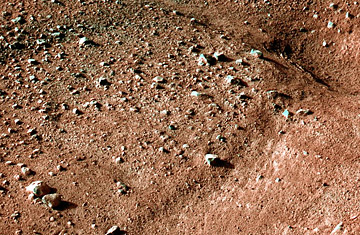
A stretch of Martian landscape seen from the Phoenix Mars Lander
There are moments in space exploration when fact and fantasy intertwine. The Mars Phoenix Lander, the latest of NASA's robotic fleet, demonstrated that after touching down in -58 F temperatures (-50 C) near the planet's north pole on May 25 at 7:38 p.m. EST. Television broadcasts relayed jubilant fist-pumps inside the Jet Propulsion Laboratory's mission control room in California along with initial images of the spacecraft's frigid new home. But a couple of blocks from the lab, two young boys riding bicycles had a more fanciful perspective. "The spaceship landed where Frosty lives,"one of them told his friend, "at the North Pole."
NASA should be so lucky as to find a button-nosed snowman in the Martian arctic. A more serious hope is that the $557 million Phoenix will help determine whether organic life is possible on the planet by securing the first sample of Martian ice for testing. Although images of the landing site, a nearly featureless plain marked by polygon-shaped cracks, may not dazzle jaded space buffs, scientists are thrilled. "I know it looks like a parking lot," said principal investigator Peter Smith, "but there's ice under that surface. This is a scientist's dream."
Because of the spacecraft's risk-filled landing, it could have easily been a nightmare—more than half of all Mars missions have ended in failure. Sitting in the mission control room during the final moments of the descent is like riding the bench during a baseball no-hitter: no one wants to jinx the outcome, so no one says a word. "Seven minutes of terror" is how Smith described the communications blackout as the spacecraft passed through the Martian atmosphere. One flight technician fidgeted with his pen. A few others rocked back and forth in their chairs, tension lines webbing their faces. Then came a simple radio burst, indicating Phoenix had reached its destination. Said Michael Wright, who helped design Phoenix's protective heat shield: "Once I heard that ping, everything was okay."
NASA's rover missions did not use rockets to cushion their landings — the spacecraft were protected by giant airbags and bounced their way to a stop on the surface. The Phoenix is the first spacecraft in 32 years to gently settle on Mars, using 12 descent engines reminiscent of techniques pioneered by the Viking probes in the 1970s. NASA says the craft is safely resting on its three pads, tilted by only one-quarter of a degree. "In my dreams it couldn't have gone as perfectly," said Barry Goldstein, Phoenix project manager.
In a few days, following system checks and the capture of hundreds of images from stereoscopic cameras, the stationary probe will begin its search for frozen water. Scientists say Mars was once flush with rivers and lakes, but most of the water escaped into space due to the planet's low gravity and thin atmosphere. What's left is believed to be concentrated at the poles. Phoenix will soon begin digging for it, extending an 8 ft. (2.35 m) robotic arm outfitted with a movable scoop. First, however, scientists will use landing-site images to build a virtual 3-D computer map of the terrain so they can operate the arm from Earth. "The arm itself is kind of dumb," said Smith, a planetary scientist at the University of Arizona, Tucson. "It doesn't even know where the surface is."
The scoop, edged with pronglike "ripper tines," is designed to crunch into the tough polar permafrost. NASA's plan is to dig trenches about 19 in. (.5 m) into the surface, a depth where scientists believe ice meets soil, and haul a sample onto the spacecraft. There, an instrument will heat the soil in tiny ovens, checking the resulting vapors for water and carbon compounds. An on-board chemistry lab with dual microscopes will add water to the sample and analyze the spectral and electrochemical results to check acidity, salt levels, and ion concentrations.
The Phoenix Lander is something of a make-good for the ill-fated Mars Polar Lander (MPL), which crashed near the south pole in 1999. The two spacecraft share the same design and Phoenix was originally headed to the planet as Mars Surveyor 2001 until the MPL crash prompted NASA to mothball the project. After correcting several design flaws, NASA resurrected Surveyor as the Mars Phoenix Lander. The space agency, which spent $100 million on Surveyor, has invested another $420 million in the improved vehicle. The Canadian Space Agency contributed another $37 million for a weather station.
The spacecraft now has about three months to study the Martian north pole before -200 F winter temperatures hit the region and threaten to freeze the instruments. But Phoenix is designed with a longer, six-to-eight-month stay in mind, so hopes are high that the probe will not only find frozen water but will also serve as a precursor to later missions seeking evidence of microscopic organic life. Which means that NASA, like Frosty, will probably be back again someday.
